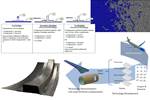Plasma treatment elevates aerocomposites surface preparation
CAMX 2024: Enhanced material performance and structural integrity, as well as reduced environmental impact is possible through Plasmatreat’s Openair-Plasma process.
Plasma technology, like Plasmatreat’s (Hayward, Calif., U.S.) Openair-Plasma, aids in enhancing the adhesion and stability of bonded joints in large-format carbon fiber-reinforced polymer (CFRP) aerospace components, crucial for long-term performance and structural integrity.
According to the company, this is particularly true for large-area components molded from prepregs. Here, plasma is capable of eliminating solvent-based release agents used in molding prepregs like Frekote, simplifying demolding processes. This results in cleaner surfaces, reduced cycle times and improved structural uniformity, benefiting overall manufacturing efficiency.
Even traditional materials such as titanium and aluminum alloys used in rivets face challenges like corrosion in aircraft environments. Openair-Plasma treatment addresses these challenges through effective surface preparation, including micro-cleaning and activation. This ensures optimal application of anti-corrosion coatings, maintaining the reliability of critical assembly components.
Furthermore, PlasmaPlus nanocoatings represent a sustainable alternative to toxic hexavalent chromium (Cr6) primers through a plasma polymerization process — essentially a dry, chemical-free plasma coating method. By introducing a precursor, this technology not only offers effective corrosion protection but also enhances surface tension and coating adhesion without compromising environmental standards.
Plasmatreat notes that the integration of plasma technology signifies a significant shift towards sustainability and efficiency in aircraft manufacturing, promoting environmental responsibility and operational efficiency.
Related Content
-
Carbon fiber, bionic design achieve peak performance in race-ready production vehicle
Porsche worked with Action Composites to design and manufacture an innovative carbon fiber safety cage option to lightweight one of its series race vehicles, built in a one-shot compression molding process.
-
The next evolution in AFP
Automated fiber placement develops into more compact, flexible, modular and digitized systems with multi-material and process capabilities.
-
Manufacturing the MFFD thermoplastic composite fuselage
Demonstrator’s upper, lower shells and assembly prove materials and new processes for lighter, cheaper and more sustainable high-rate future aircraft.

















